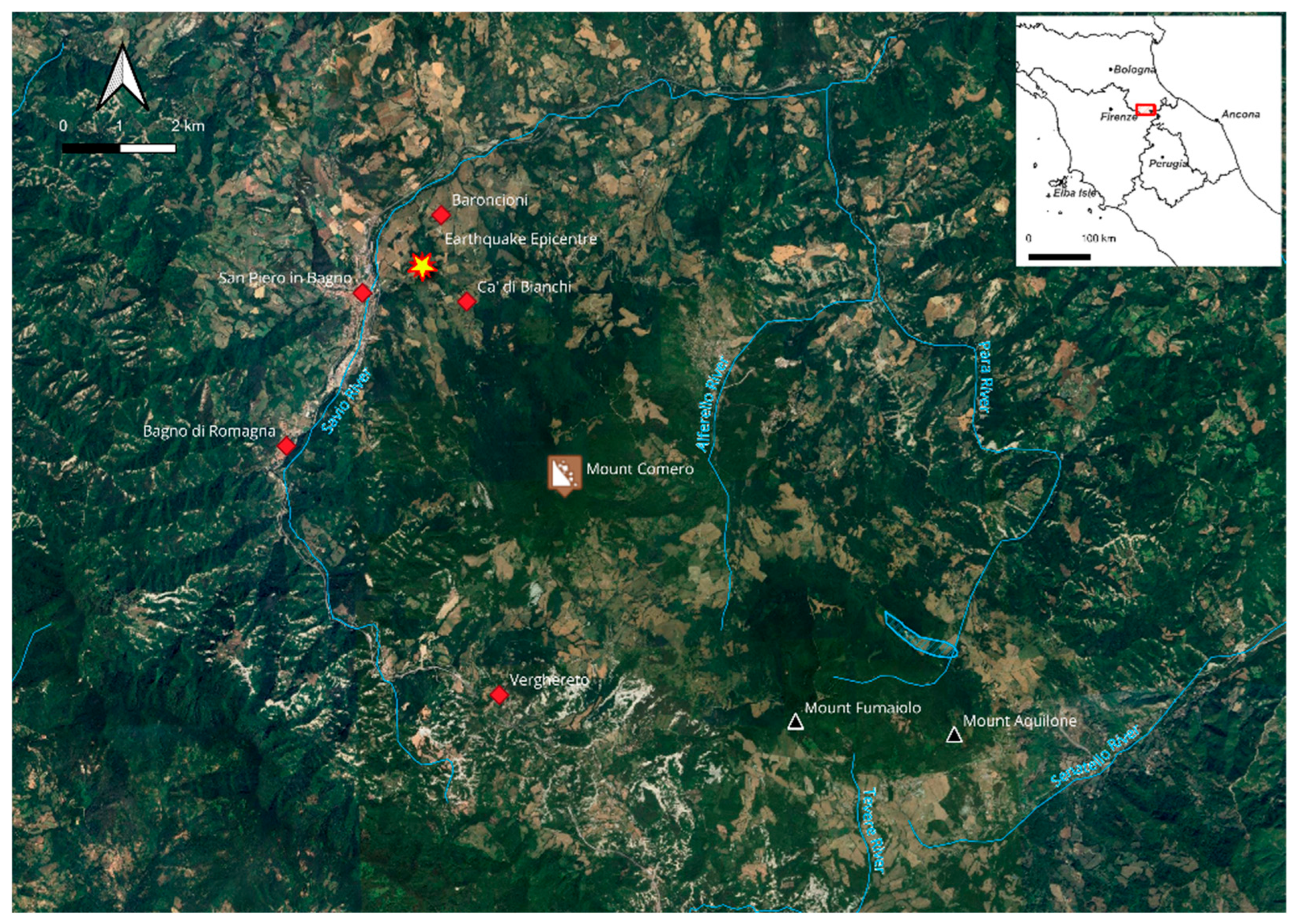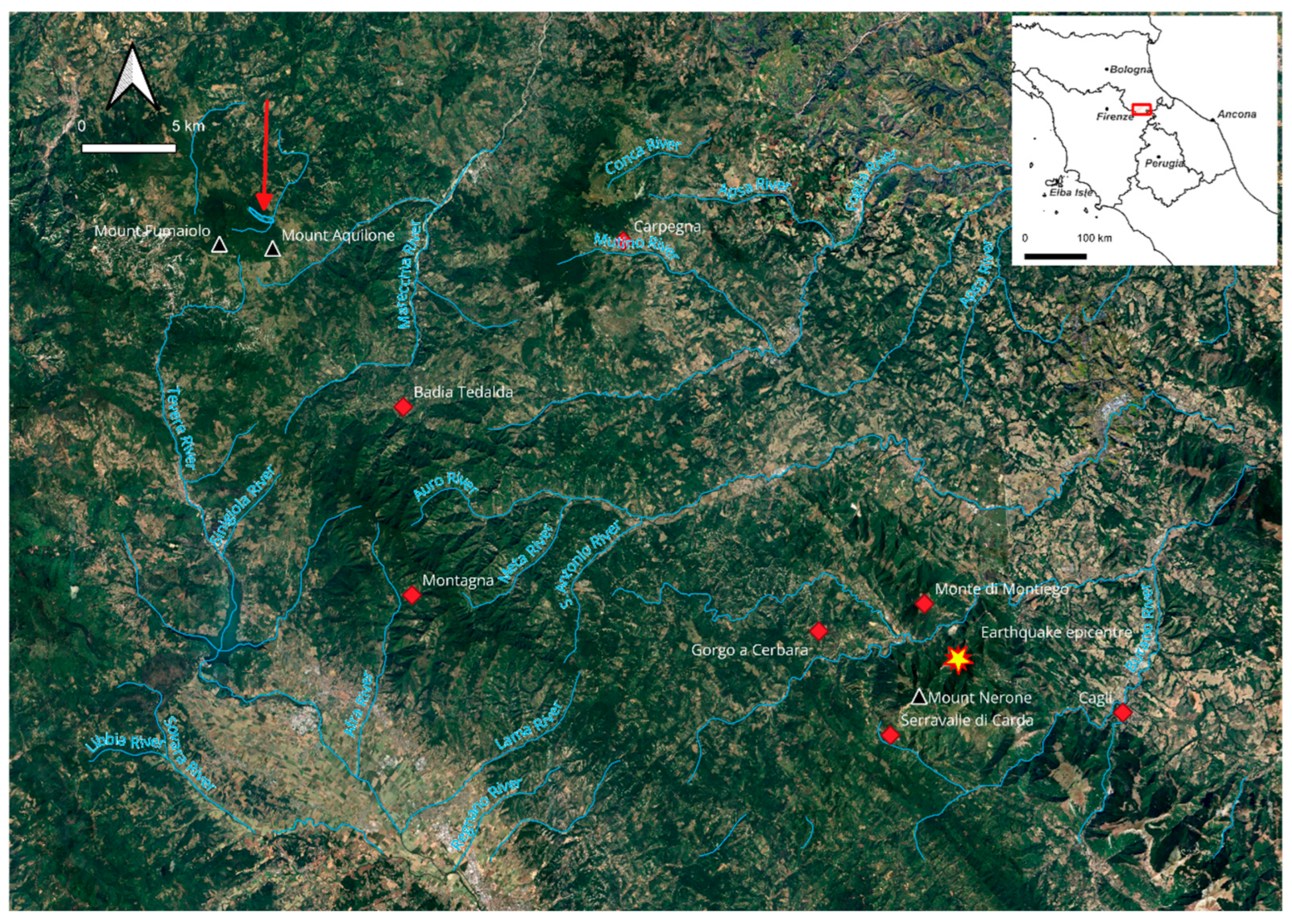The Background of the Gioconda: Geomorphological and Historical Data from the Montefeltro Area (Tuscan–Emilian Apennines, Central Italy)
Abstract
1. Introduction
2. Geomorphological Setting of the Area
3. Materials and Methods
4. Results
4.1. The Identity of La Gioconda
4.2. The Gioconda Landscape
4.2.1. Sector A: The Bridge near Pennabilli Village and the Midway Senatello Valley
4.2.2. Sector B: The Left Side of the Painting
4.2.3. Sector C: Mount Fumaiolo and the Lake, New Geomorphological and Historical Data
5. Discussion
6. Conclusions
Author Contributions
Funding
Data Availability Statement
Conflicts of Interest
References
- Borchia, R.; Nesci, O. Il Codice P., Atlante Illustrato Del Reale Paesaggio Della Gioconda; Electa-Mondadori: Milano, Italy, 2012; pp. 1–143. [Google Scholar]
- Nesci, O.; Borchia, R. Landscapes and Landforms of the Duchy of Urbino in Italian Renaissance Paintings. In Landscapes and Lanforms of Italy, World Geomorphological Landscapes; Soldati, M., Marchetti, M., Eds.; Springer International Publishing: Berlin/Heidelberg, Germany, 2017; Volume 22, pp. 257–269. [Google Scholar]
- Nesci, O.; Borchia, R.; Valentini, L. The backgrounds of Renaissance paintings in the ancient Duchy of Urbino (Central Italy): Exploring new forms of valorization of Geoheritage through their inclusion in UNESCO cultural landscapes. Geosciences 2024, 14, 76. [Google Scholar] [CrossRef]
- Fredi, P.; Lupia Palmieri, E. Morphological Regions of Italy. In Landscapes and Lanforms of Italy, World Geomorphological Landscapes; Soldati, M., Marchetti, M., Eds.; Springer International Publishing: Berlin/Heidelberg, Germany, 2017; Volume 22, pp. 39–74. [Google Scholar] [CrossRef]
- Alvarez, W. A review of the Earth history record in the Cretaceous, Paleogene, and Neogene pelagic carbonates of the Umbria- Marche Apennines (Italy): Twenty-five years of the Geological Observatory of Coldigioco. In 250 Million Years of Earth History in Central Italy: Celebrating 25 Years of the Geological Observatory of Coldigioco; Geological Society of America Special Paper 2019; Koeberl, C., Bice, D.M., Eds.; Geological Society of America: Boulder, CO, USA, 2019; Volume 542, pp. 1–58. [Google Scholar] [CrossRef]
- Scisciani, V. Styles of positive inversion tectonics in the Central Apennines and in the Adriatic foreland: Implications for the evolution of the Apennine chain (Italy). J. Struct. Geol. 2009, 31, 1276–1294. [Google Scholar] [CrossRef]
- Mariucci, M.T.; Amato, A.; Montone, P. Recent tectonic evolution and present stress in the Northern Apennines (Italy). Tectonics 2010, 18, 108–118. [Google Scholar] [CrossRef]
- Boccaletti, M.; Corti, G.; Martelli, L. Recent and active tectonics of the external zone of the Northern Apennines (Italy). Int. J. Earth Sci. (Geol. Rundsch) 2010, 100, 1331–1348. [Google Scholar] [CrossRef]
- Deiana, G.; Pialli, G. The structural provinces of the Umbro-Marchean Apennines. Mem. Soc. Geol. It. 1994, 48, 473–484. [Google Scholar]
- De Feyter, A.J. Gravity tectonics and sedimentation of the Montefeltro, ltaly. Geol. Ultraiect. 1991, 35, 1–168. [Google Scholar]
- Passeri, L. Appennino Umbro-Marchigiano. Guide Geologiche Regionali 7. Società Geologica Italiana; BE-MA: Milano, Italy, 1994; pp. 1–301. [Google Scholar]
- Barchi, M.R.; Alvarez, W.; Shimabukuro, D.H. The Umbria-Marche Apennines as a double orogen: Observations and hypotheses. Ital. J. Geosci. 2012, 131, 258–271. [Google Scholar] [CrossRef]
- Bartolini, C. When did the Northern Apennine become a mountain chain. Quat. Int. 2003, 101–102, 75–80. [Google Scholar] [CrossRef]
- Mazzanti, R.; Trevisan, L. Evoluzione della rete idrografica nell’Appennino centro-settentrionale. Geogr. Fis. Dinam. Quat. 1978, 1, 55–62. [Google Scholar]
- Mazzoli, S.; Deiana, G.; Galdenzi, S.; Cello, G. Miocene fault-controlled sedimentation and thrust propagation in the previously faulted external zones of the Umbria-Marche Apennines, Italy. EGU Stephan Mueller Spec. Publ. Ser. 2002, 1, 195–209. [Google Scholar] [CrossRef]
- Conti, S. Geologia dell’Appennino marchigiano romagnolo tra le valli del Savio e del Foglia (Note illustrative alla carta geologica a scala 1:50.000). Boll. Soc. Geol. It. 1989, 108, 453–490. [Google Scholar]
- Perrone, V.; Terrotta, S.; Marsaglia, K.; Distaso, A.; Tiberi, V. The Oligocene ophiolite derived breccias and sandstones of the Val Marecchia Nappe: Insights for paleogeography and evolution of Northern Apennines (Italy). Palaeogeogr. Palaeoclimatol. Palaeoecol. 2014, 394, 128–143. [Google Scholar] [CrossRef]
- Pignone, R.; Cazzoli, M.A.; Daniele, G.; Lucente, C.C. Itinerari Geologico-Ambientali Nella Valle Del Marecchia; Scala 1:60.000; Servizio Geologico, Sismico e dei Suoli, Regione Emilia Romagna: Bologna, Italy, 2015. [Google Scholar]
- Nesci, O.; Savelli, D.; Troiani, F. Types and development of stream terraces in the Marche Apennines (central Italy): A review and remarks on recent appraisals. Géomorphologie 2012, 2, 215–238. [Google Scholar] [CrossRef]
- Calderoni, G.; Cilla, G.; Dramis, F.; Gobbi, C. Environmental changes and human settlement in the central Marches (Italy) during the early-middle Holocene. Physio-Geo 2007, 1, 21–32. [Google Scholar] [CrossRef]
- Veggiani, A. Variazioni Climatiche e Trasformazioni Ambientali nel Montefeltro Marecchiese in Epoca Storica Con Riferimenti al Territorio di Casteldelci; Le Penne: Casteldelci, Italy, 1994; p. 48. [Google Scholar]
- Holzhausen, H.; Magny, M.; Zumbuühl, H.J. Glacier and lake-level variations in west-central Europe over the last 3500 years. Holocene 2005, 15, 789–801. [Google Scholar] [CrossRef]
- Mann, M.E. Little ice age. In The Earth System: Physical and Chemical Dimensions of Global Environmental Change, Vol 1, Encyclopedia of Global Environmental Change; Mac Cracken, M.C., Perry, J.S., Eds.; Wiley: Chichester, UK, 2002; pp. 504–509. [Google Scholar]
- Orombelli, G. Holocene mountain glacier fluctuations: A global overview. Geogr. Fis. Dinam. Quat. 2011, 34, 17–24. [Google Scholar]
- Pedretti, C. Studi Vinciani, Documenti, Analisi e Inediti leonardeschi; Librairie e Droz.: Genève, Switzerland, 1957; pp. 1–306. [Google Scholar]
- Zapperi, R. Abschied von Mona Lisa Das berühmteste Gemälde Der Welt Wird Enträtselt; C.H. Beck Verlag: München, Germany, 2010; pp. 1–159. [Google Scholar]
- Bortolin, G.A.; Tartari, C.A. D’illustri Città, Messeri e Leggiadre Madonne: The journey of Cardinal Luigi d’Aragona to Germany, Holland, France and Italy, 1517–1518 Written by Antonio de Beatis, Transposed from the Original in the Vernacular, Ludwig Pastor Ed. (Friburgo in Brisgovia, 1905); Terra Santa Ed.: Milano, Italy, 2012; pp. 1–208. [Google Scholar]
- Perrig, A. Leonardo: Die Anatomie der Erde. Jahrb. Hambg. Kunstsammlungen 1980, 25, 51–80. [Google Scholar]
- Coccioni, R. Leonardo da Vinci, Rocce, Fossili e Altre Simili Cose; Aras Ed.: Fano, Italy, 2019; pp. 1–241. [Google Scholar]
- Nanni, R. Usi diversi di appunti di paesaggio in Leonardo. In Leonardo Genio e Cartografo. La Rappresentazione del Territorio Tra Scienza e Arte; A cura di Andrea Cantile, Istituto Geografico Militare: Firenze, Italy, 2003; pp. 263–275. [Google Scholar]
- Starnazzi, C. Le Carte di Leonardo: Un nuovo concetto di spazio. In Leonardo Genio e Cartografo. La Rappresentazione del Territorio tra Scienza e Arte; A cura di Andrea Cantile, Istituto Geografico Militare: Firenze, Italy, 2003; pp. 277–297. [Google Scholar]
- Guerra, C. Amazing history of an amazing landscape. In A Treasure of Nature. Colors, Scents, Silences and Noises Along the Marecchia and Conca Valleys; Guaitoli, S., Ed.; Lithos arti grafiche: Villa Verucchio, Italy, 2020; pp. 33–39. [Google Scholar]
- Sacco, D. Archeologia dei paesaggi in Leonardo da Vinci: Analisi di un attraversamento. In Il Codice P. Atlante Illustrato del Paesaggio Reale Della Gioconda; Borchia, R., Nesci, O., Eds.; Electa Mondadori: Milano, Italy, 2012; pp. 134–141. [Google Scholar]
- Valentini, L.; Guerra, V.; Nesci, O. The Mt. Catria–Mt. Nerone Ridge in the North-Marchean Apennines (Central Italy): A Potential Geopark? Sustainability 2023, 15, 11382. [Google Scholar] [CrossRef]
- Valentini, L.; Nesci, O. A new approach to enhance the appeal of the Italian territory through art: Three study cases from Marche Region. Arab. J. Geosci. 2021, 14, 144. [Google Scholar] [CrossRef]
- Vona, S. I Castelli in Leonardo da Vinci. In Il Codice P. Atlante Illustrato del Paesaggio Reale Della Gioconda; Borchia, R., Nesci, O., Eds.; Electa Mondadori: Milano, Italy, 2012; pp. 142–143. [Google Scholar]
- Canuti, P.; Casagli, N.; Garzonio, C.A.; Vannocci, P. Lateral spreads and landslide hazards in the Northern Apennine. The example of Mt. Fumaiolo (Emilia-Romagna) and Chiusi della Verna (Tuscany). In Proceedings of the 6th International Congress International Association of Engineering Geology, Amsterdam, The Netherlands, 6–10 August 1990; pp. 1525–1533. [Google Scholar]
- Coltorti, M.; Dramis, F.; Pambianchi, G. Stratified slope-waste deposits in the Esino river basin (Umbria-Marche Apennines, Central Italy). Polarforsch. Bremerhav. Alfred Wegener Inst. Polar Mar. Res. Ger. Soc. Polar Res. 1983, 53, 59–66. [Google Scholar]
- Repetti, E. Dizionario Geografico Fisico Storico Della Toscana; Ed. coi tipi di Giovanni Massoni: Firenze, Italy, 1843; pp. 1–868. [Google Scholar]
- Persi, P.; Veggiani, A.; Lombardi, F.V.; Battistelli, M.; Renzi, G.; Allegretti, G. Le Frane Nella Storia Della Valmarecchia; Le Penne Ed: Pesaro, Italy, 1993; pp. 1–110. [Google Scholar]
- Piastra, S.; Landuzzi, A.; Cencini, C. Historical landslides (XVII–XIX centuries) from Romagna Apennines, Northern Italy. A cultural approach. In Proceedings of the 6th International Congress on Geomorphology, Zaragoza, Spain, 7–11 September 2005; p. 410. [Google Scholar]
- Gambi, L. I laghi di frana dell’Appennino Romagnolo. Boll. Soc. Geogr. It. 1948, 1, 10–54. [Google Scholar]
- Amari, M.; Schiapparelli, C. L’Italia Descritta nel Libro del Re Ruggero l Compilato da EDRISI. Testo Arabo Pubblicato con Versione e Note; Atti della Reale Accademia dei Lincei: Roma, Italy, 1883; 1876/77, Serie 2; Volume VIII, pp. 1–155. [Google Scholar]
- Dramis, F.; Farabollini, P.; Gentili, B.; Pambianchi, G. Neotectonic and large-scale gravitational phenomena in the Umbria-Mar- che Apennines, Italy. In Steepland Geomorphology; Slaymaker, O., Ed.; Wiley: Chichester, UK, 1995; pp. 199–217. [Google Scholar]
- Mantovani, E.; Viti, M.; Cenni, N.; Babbucci, D.; Tamburelli, C.; Baglione, M.; D’Intinosante, V. Seismotectonics and present seismic hazard in the Tuscany–Romagna–Marche–Umbria Apennines (Italy). J. Geodyn. 2015, 89, 1–14. [Google Scholar] [CrossRef]
- Frosali, L. Le frane della valle del Savio e le opere di consolidamento necessarie. In Rivista Tecnica del Collegio Nazionale Degli Ingegneri Provinciali e Comunali; Vallardi Editore: Milano, Italy, 1916; pp. 10–17. [Google Scholar]
- Guidoboni, E.; Ferrari, G.; Mariotti, D.; Comastri, A.; Tarabusi, G.; Sgattoni, G.; Valensise, G. CFTI5Med, Catalogo dei Forti Terremoti in Italia (461 a.C.-1997) e Nell’area Mediterranea (760 a.C.-1500); Istituto Nazionale di Geofisica e Vulcanologia (INGV): Bologna, Italy, 2018. [Google Scholar] [CrossRef]
- Guidoboni, E.; Ferrari, G.; Tarabusi, G.; Sgattoni, G.; Comastri, A.; Mariotti, D.; Ciuccarelli, C.; Bianchi, M.G.; Valensise, G. CFTI5Med, the new release of the catalogue of strong earthquakes in Italy and in the Mediterranean area. Sci. Data 2019, 6, 80. [Google Scholar] [CrossRef]
- Zei, C.; Tarabusi, G.; Ciuccarelli, C.; Burrato, P.; Sgattoni, G.; Taccone, R.C.; Mariotti, D. CFTIlandslides, Italian Database of historical earthquake-induced landslides. Sci. Data 2024, 11, 834. [Google Scholar] [CrossRef]
- Baratta, M. Sul terremoto di Cagli del 3 giugno 1781. In Memorie Della Società Geografica Italiana; Nabu Press: Roma, Italy, 1896; Volume 5, pp. 363–383. [Google Scholar]
- Keefer, D.K. Landslides caused by earthquakes. GSA Bull. 1984, 95, 406–421. [Google Scholar] [CrossRef]
- Valentini, L.; Guerra, V.; Lazzari, M. Enhancement of Geoheritage and Development of Geotourism: Comparison and Inferences from Different Experiences of Communication through Art. Geosciences 2022, 12, 264. [Google Scholar] [CrossRef]
- Nesci, O.; Valentini, L. Science, poetry, and music for landscapes of the Marche Region, Italy: Communicating the conservation of the natural heritage. Geosci. Commun. 2020, 3, 393–406. [Google Scholar] [CrossRef]

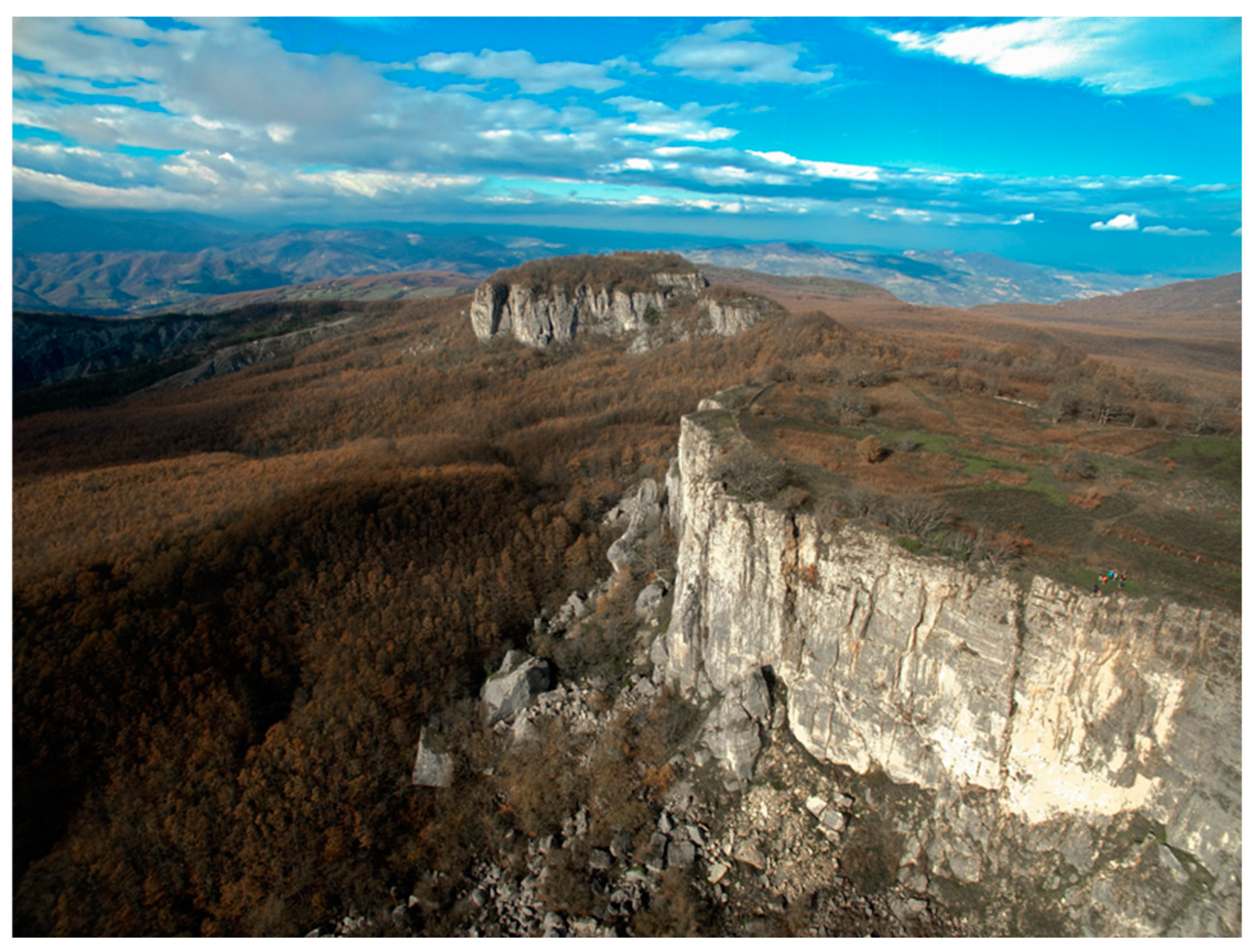

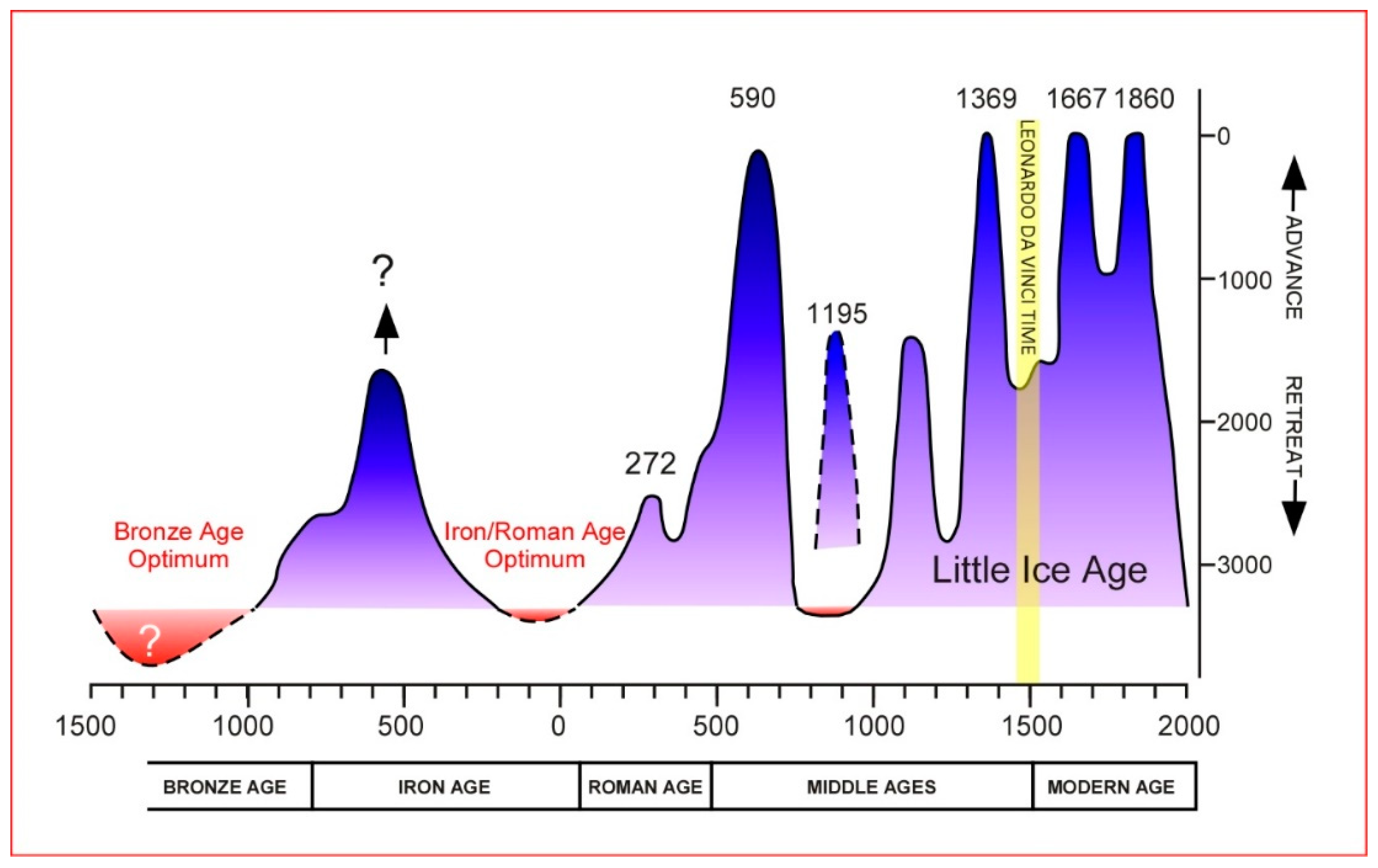

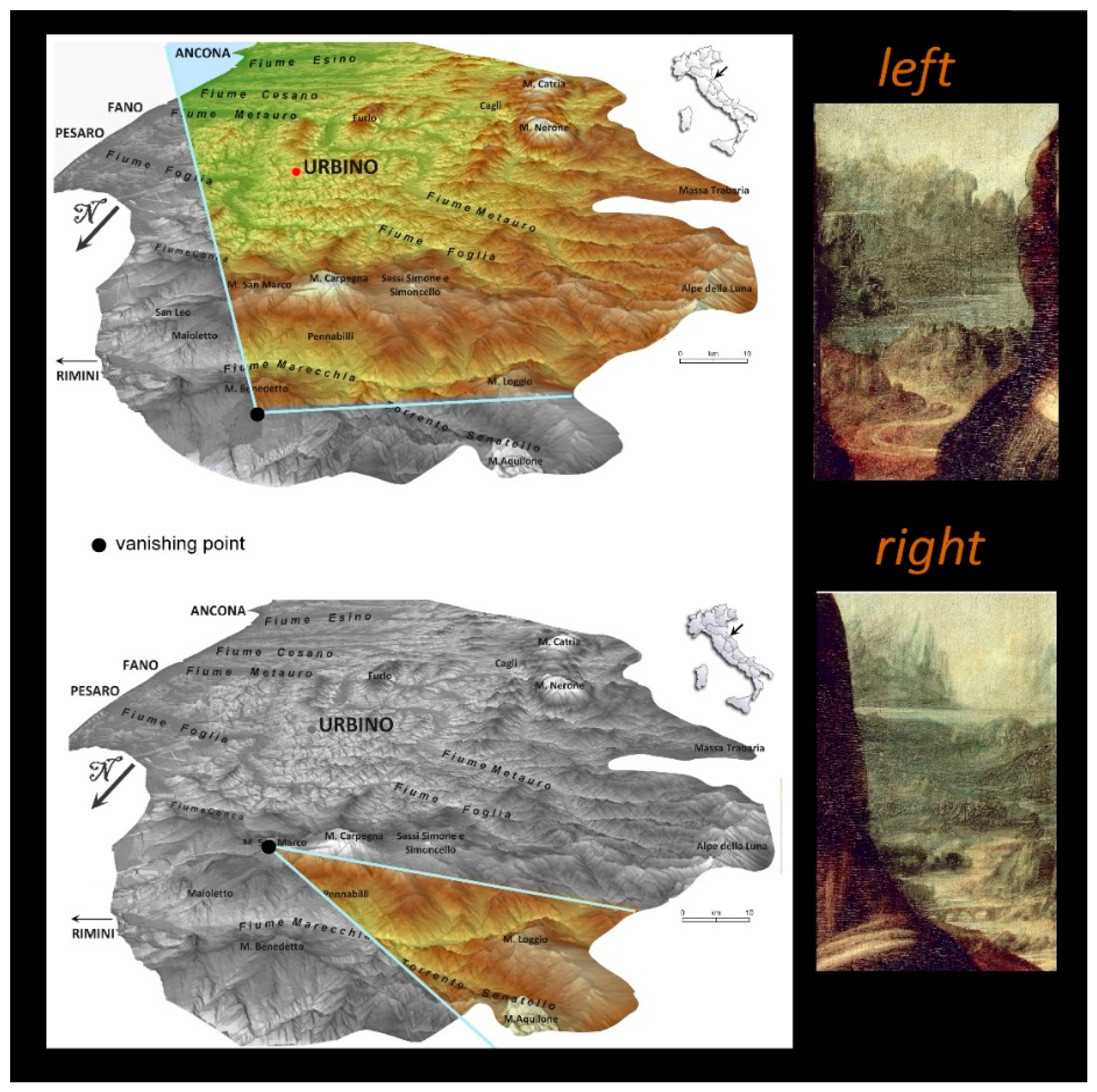
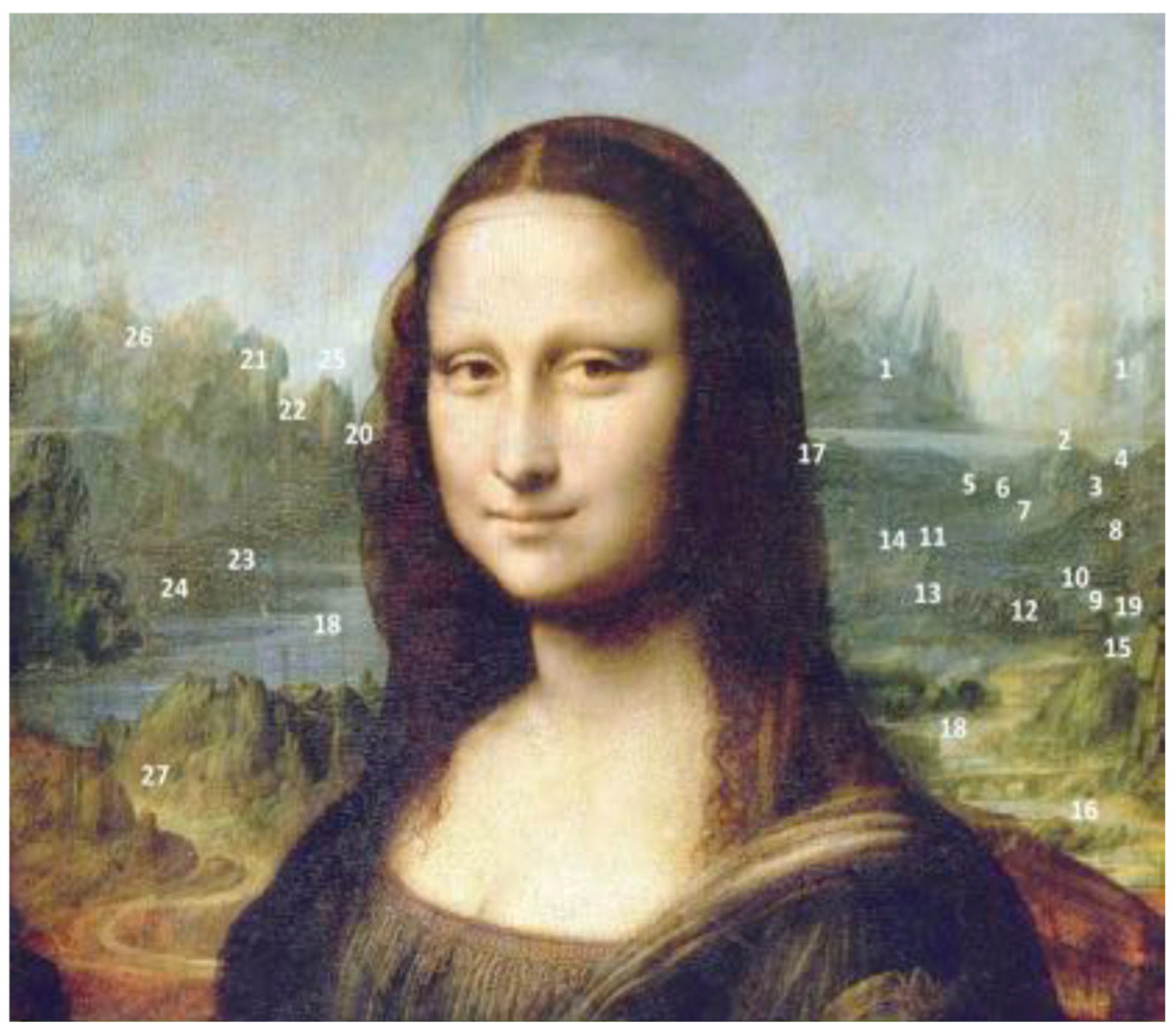
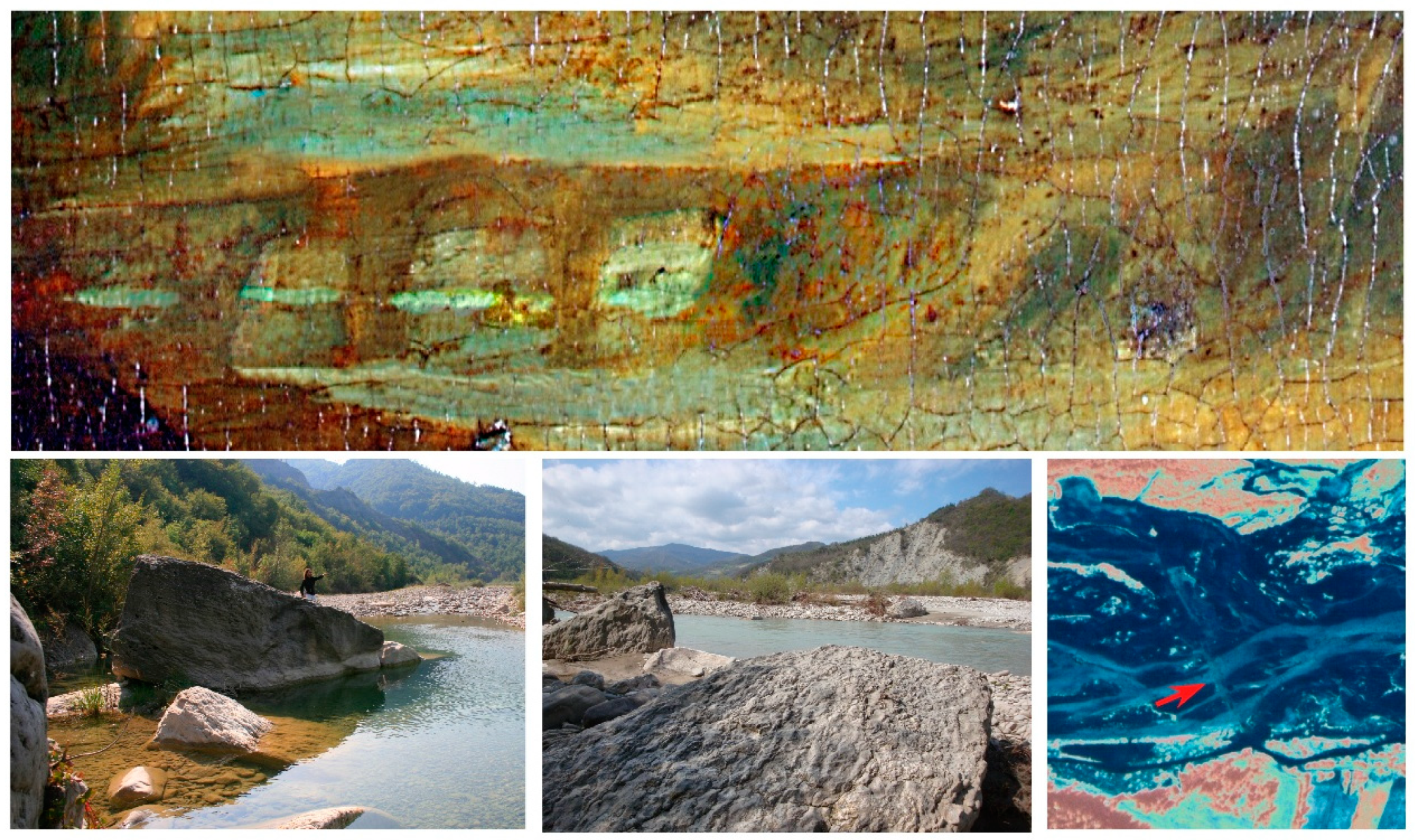
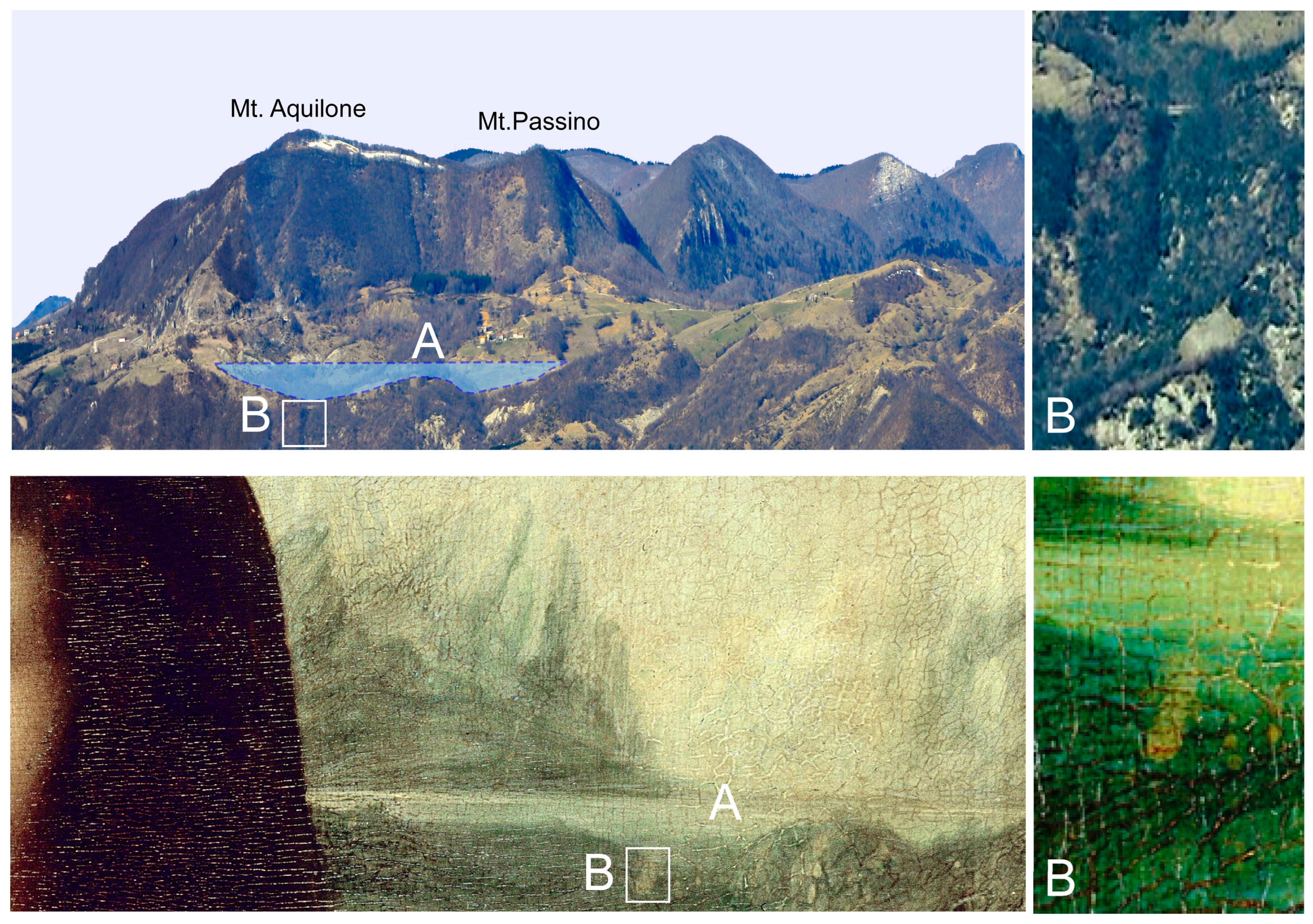
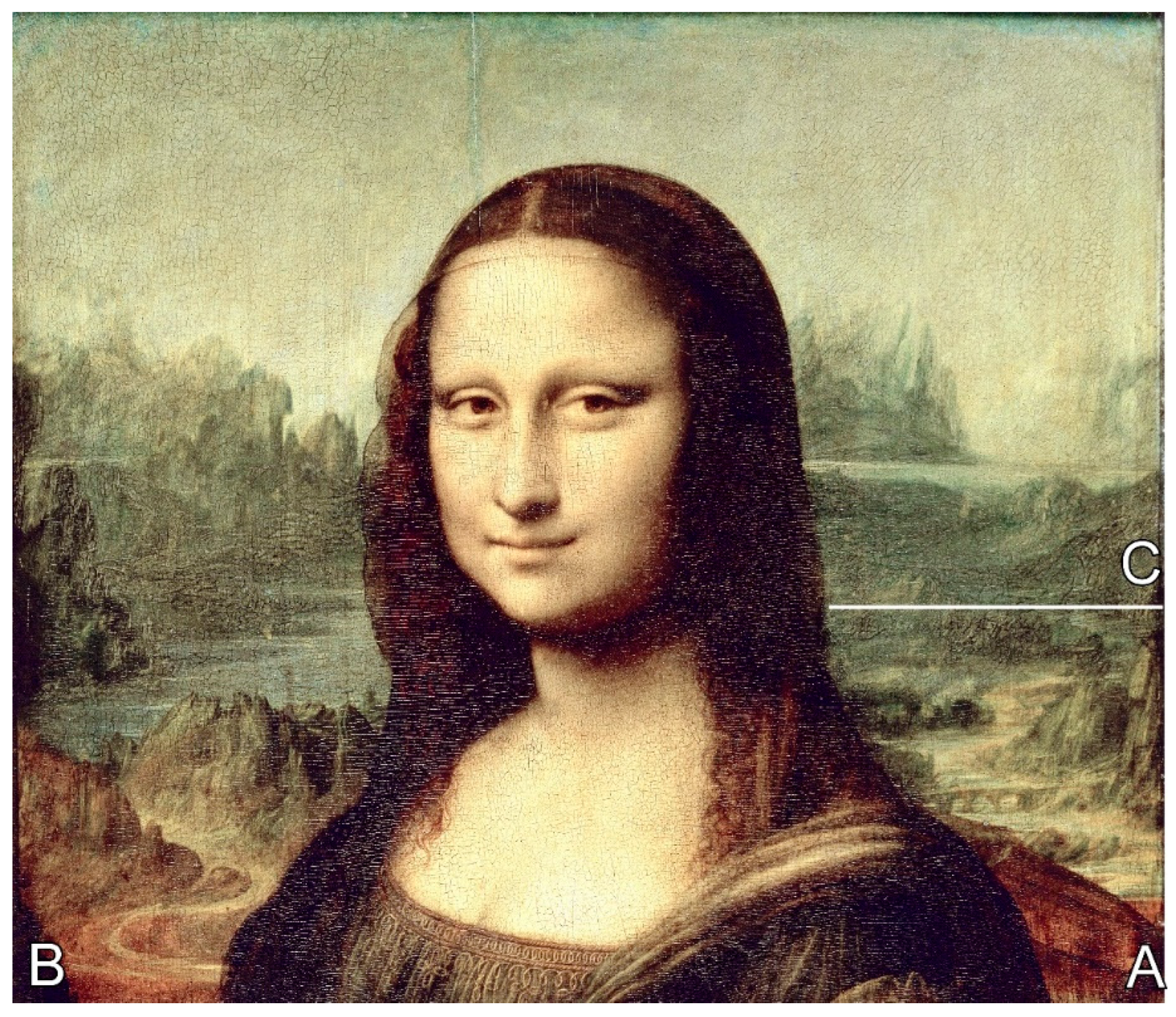
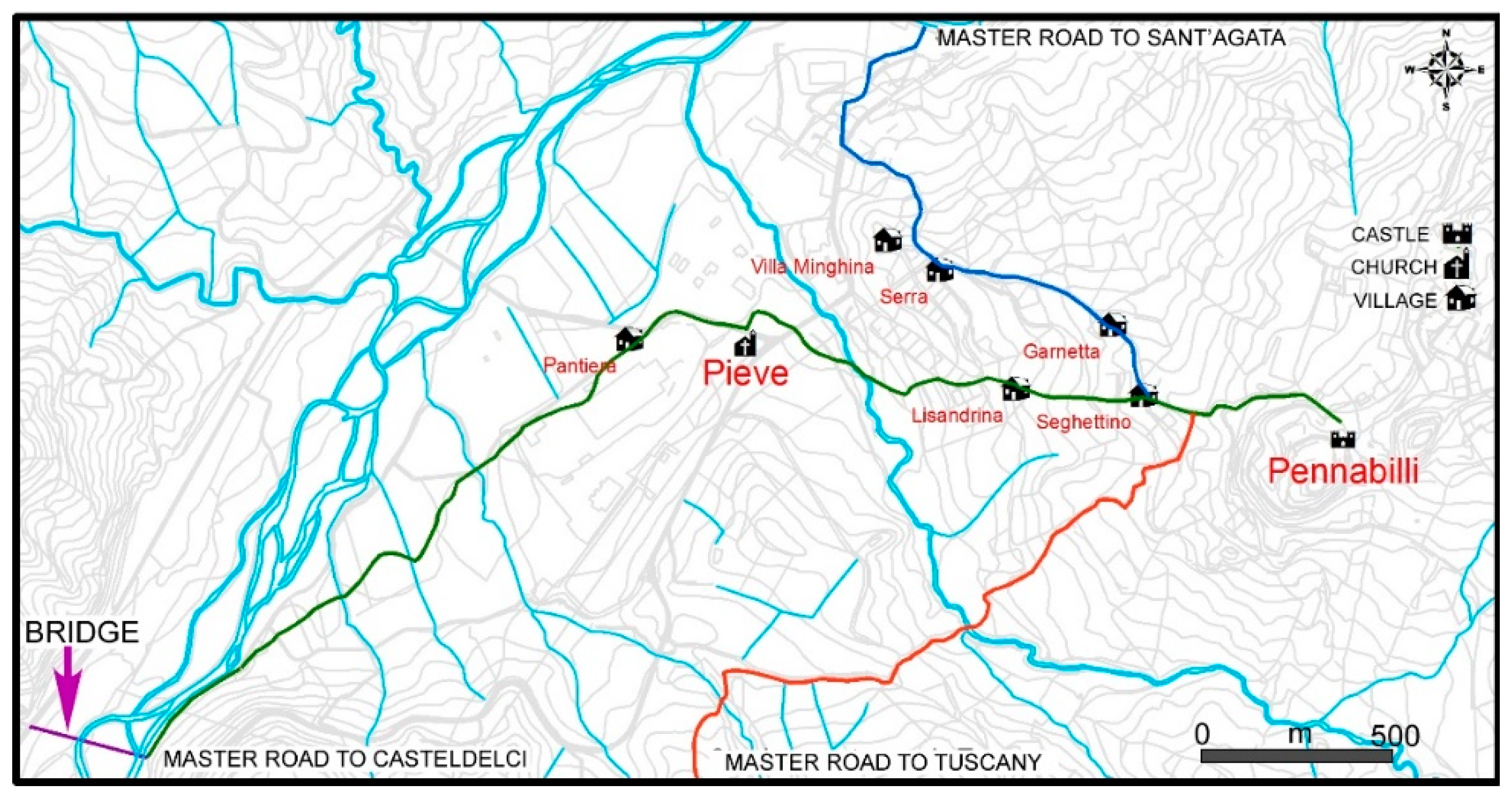

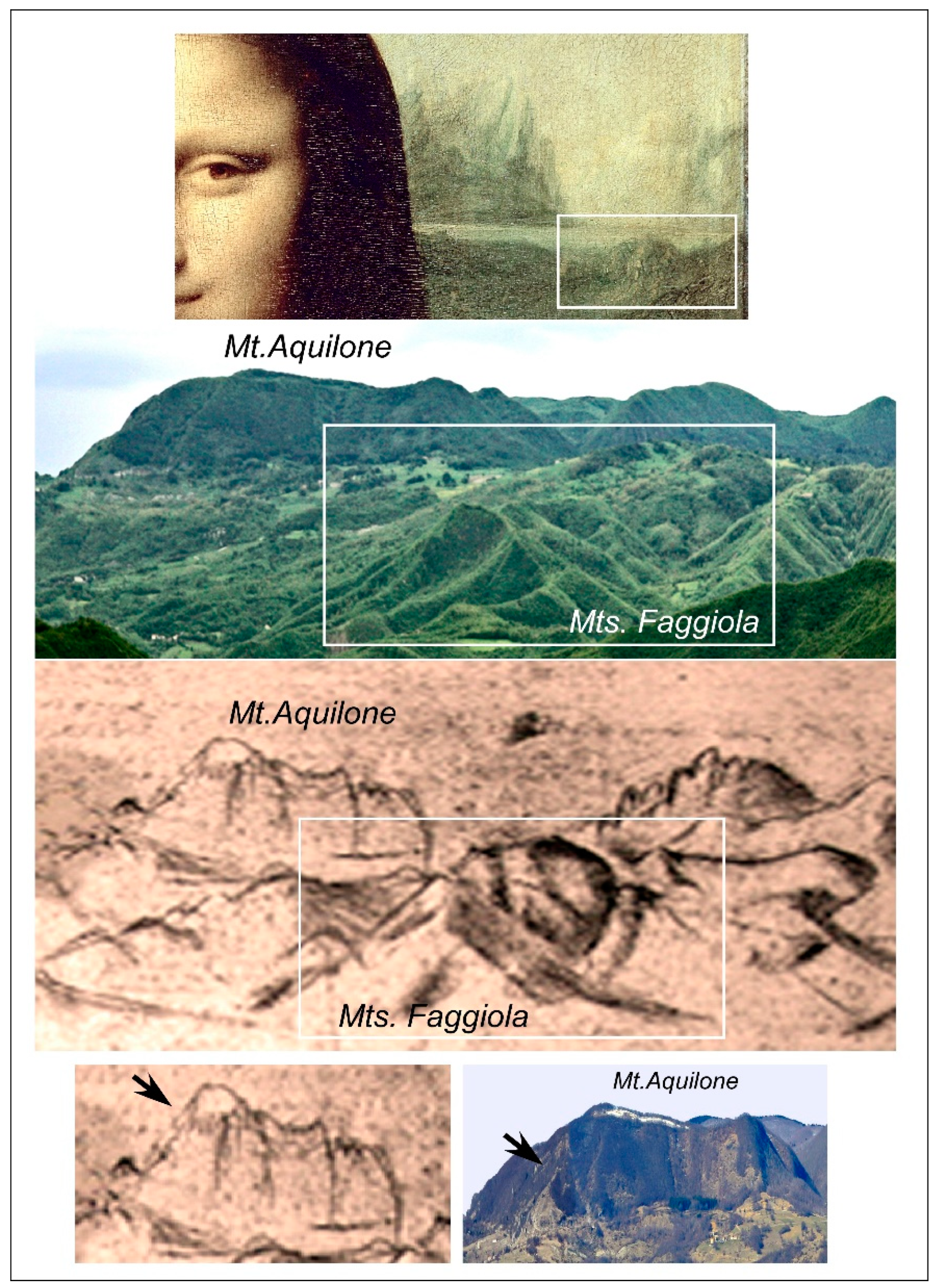
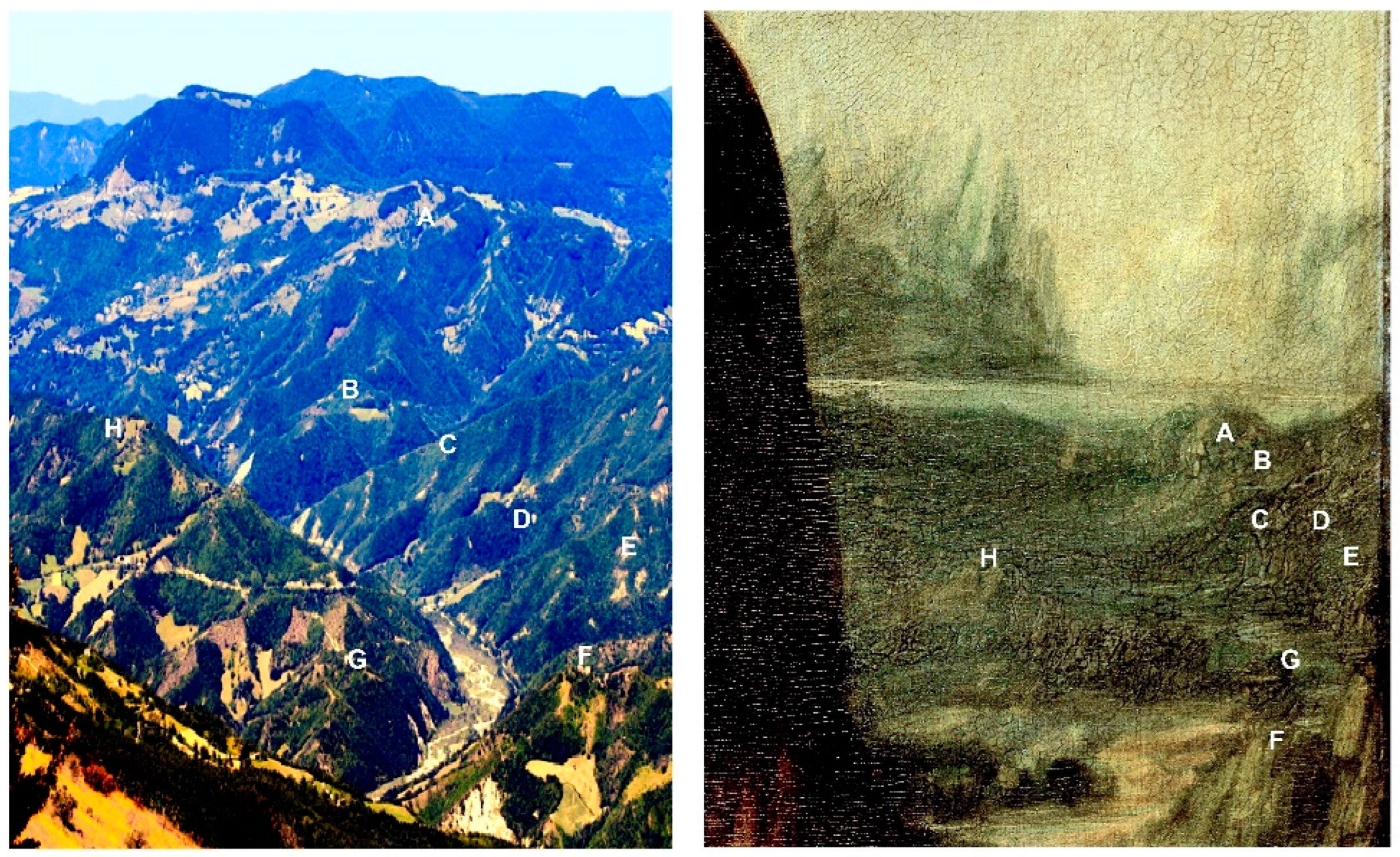
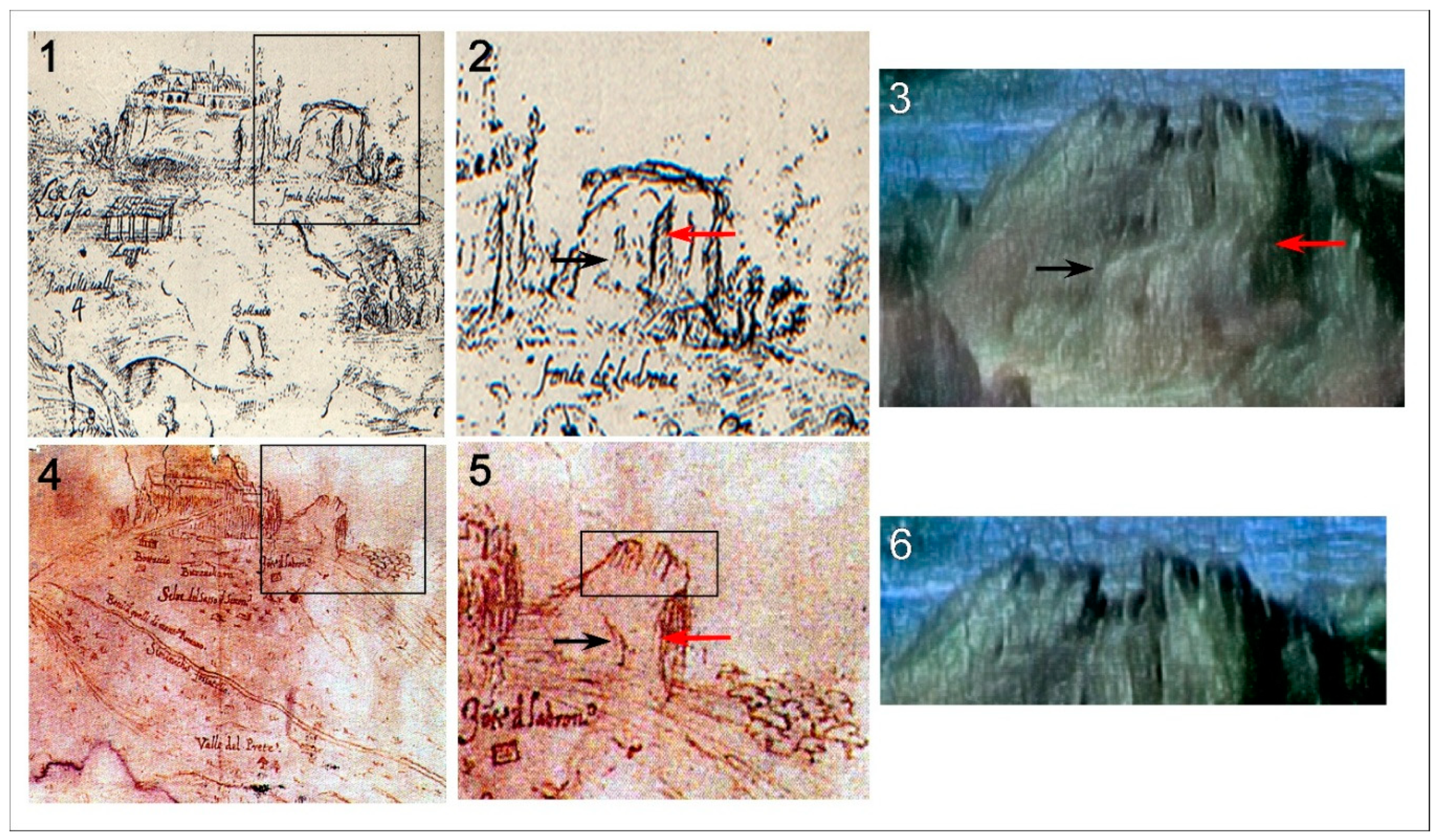

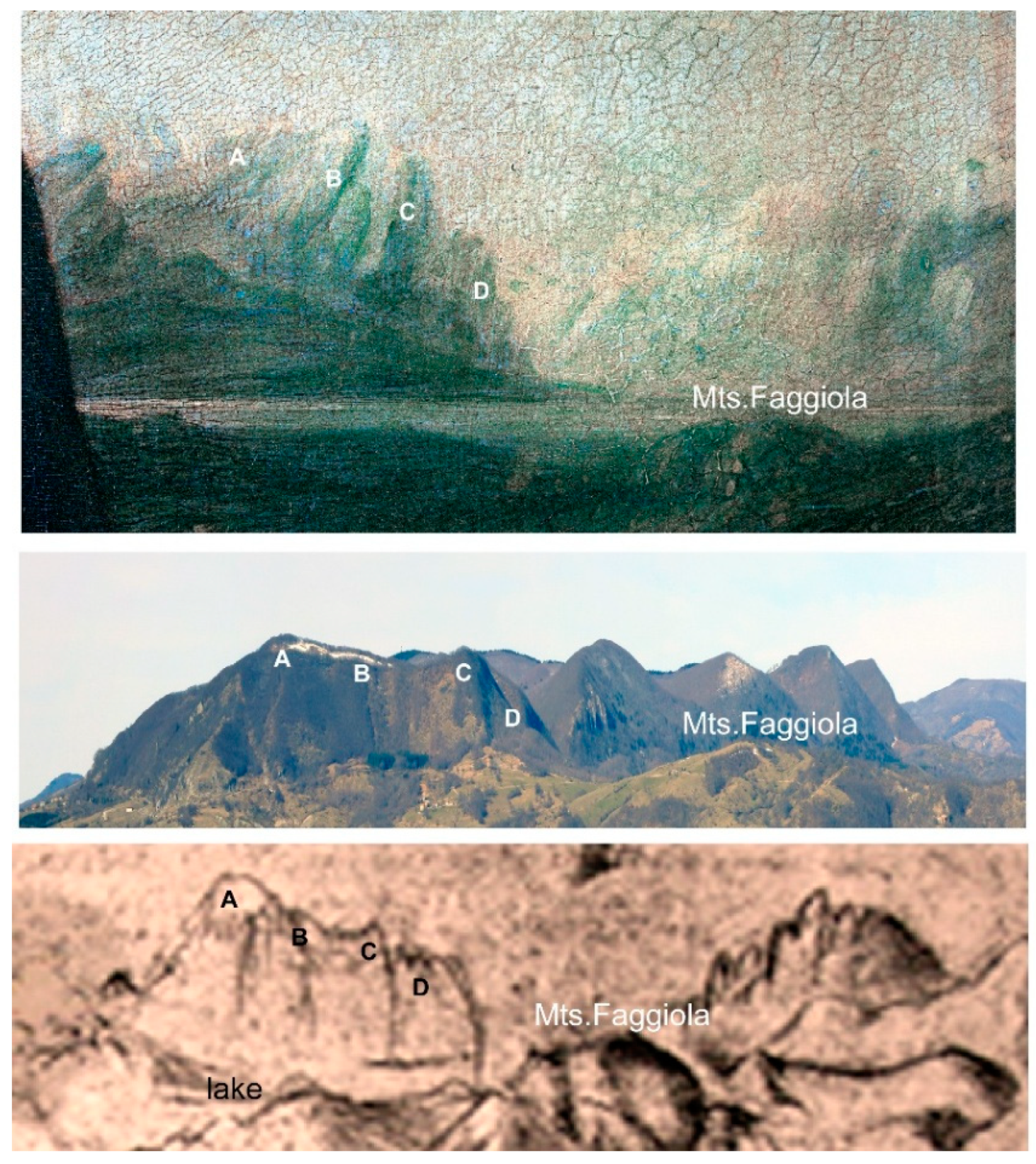
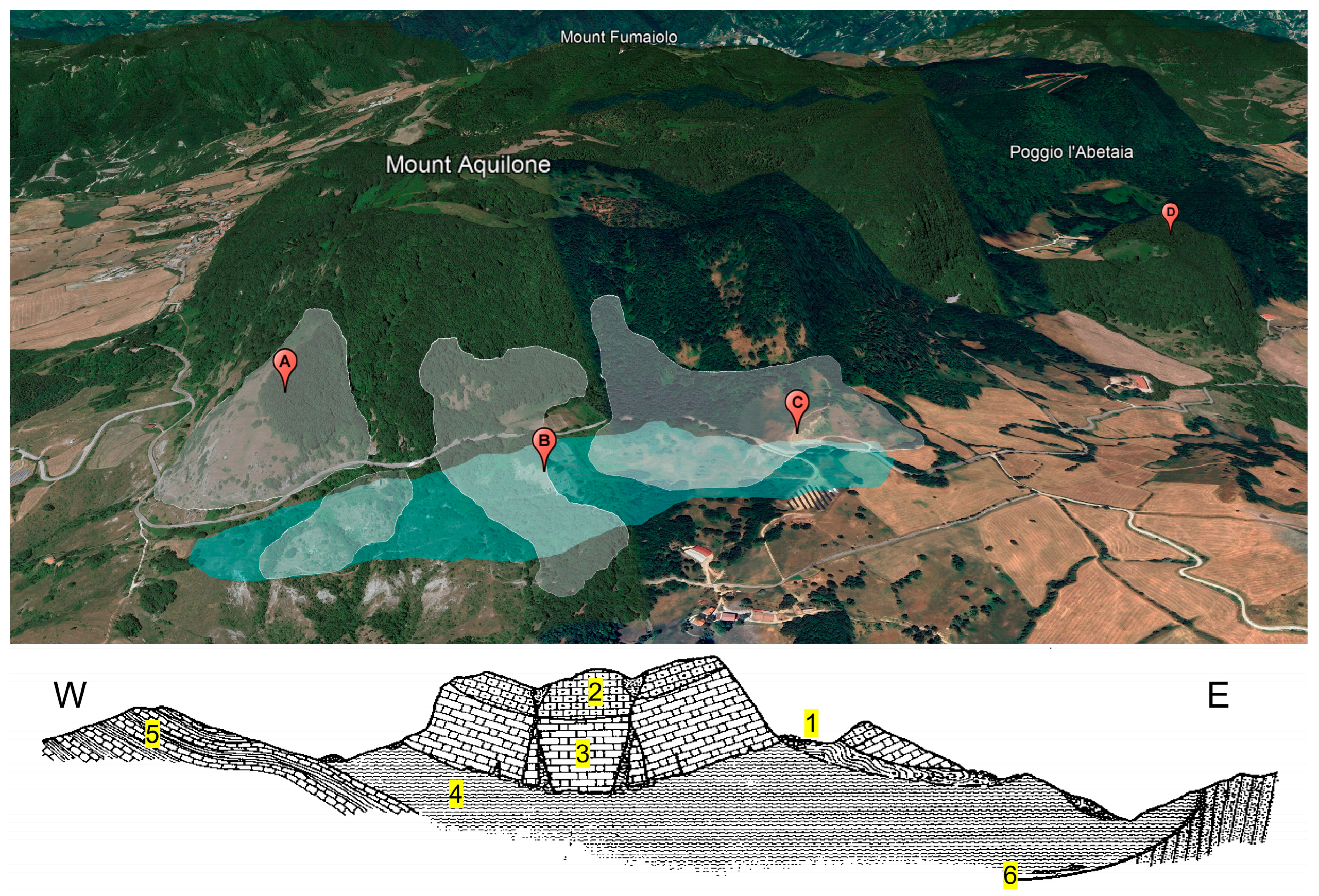
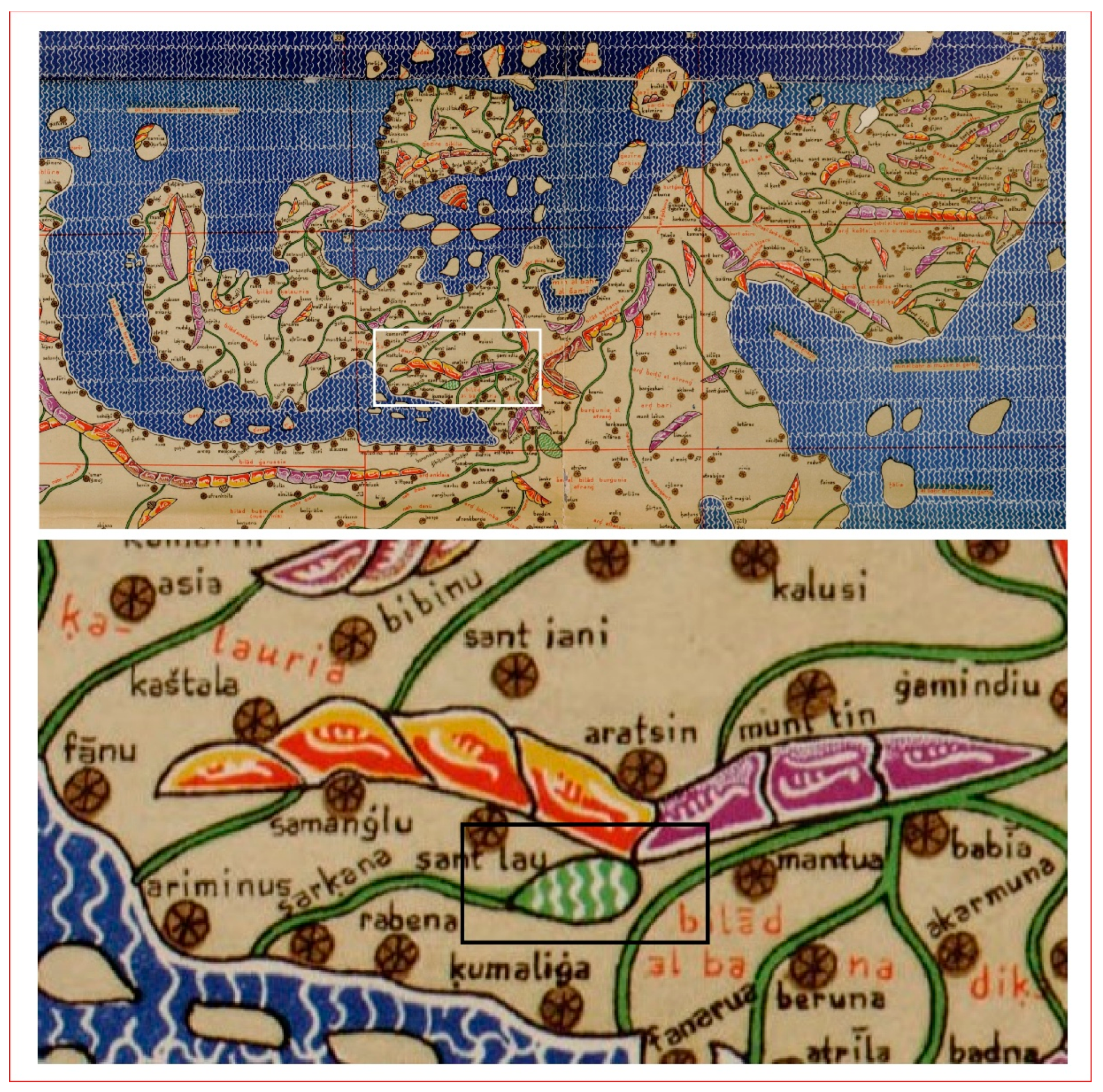
Disclaimer/Publisher’s Note: The statements, opinions and data contained in all publications are solely those of the individual author(s) and contributor(s) and not of MDPI and/or the editor(s). MDPI and/or the editor(s) disclaim responsibility for any injury to people or property resulting from any ideas, methods, instructions or products referred to in the content. |
© 2025 by the authors. Licensee MDPI, Basel, Switzerland. This article is an open access article distributed under the terms and conditions of the Creative Commons Attribution (CC BY) license (https://creativecommons.org/licenses/by/4.0/).
Share and Cite
Nesci, O.; Borchia, R.; Pappafico, G.; Valentini, L. The Background of the Gioconda: Geomorphological and Historical Data from the Montefeltro Area (Tuscan–Emilian Apennines, Central Italy). Land 2025, 14, 1007. https://doi.org/10.3390/land14051007
Nesci O, Borchia R, Pappafico G, Valentini L. The Background of the Gioconda: Geomorphological and Historical Data from the Montefeltro Area (Tuscan–Emilian Apennines, Central Italy). Land. 2025; 14(5):1007. https://doi.org/10.3390/land14051007
Chicago/Turabian StyleNesci, Olivia, Rosetta Borchia, Giulio Pappafico, and Laura Valentini. 2025. "The Background of the Gioconda: Geomorphological and Historical Data from the Montefeltro Area (Tuscan–Emilian Apennines, Central Italy)" Land 14, no. 5: 1007. https://doi.org/10.3390/land14051007
APA StyleNesci, O., Borchia, R., Pappafico, G., & Valentini, L. (2025). The Background of the Gioconda: Geomorphological and Historical Data from the Montefeltro Area (Tuscan–Emilian Apennines, Central Italy). Land, 14(5), 1007. https://doi.org/10.3390/land14051007






